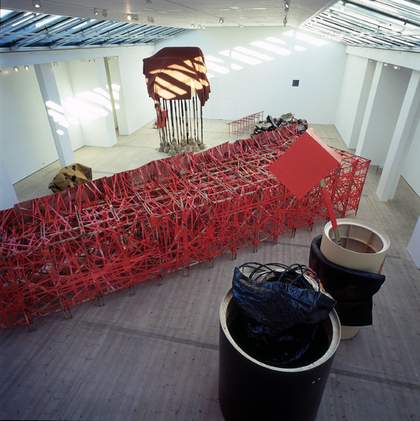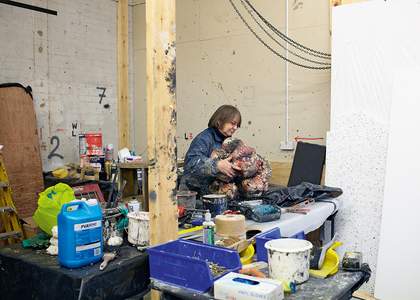
Phyllida Barlow and her work in her south London studio in November 2013
© Robin Friend
Phyllida Barlow’s studio looks like a builder’s merchants after a hurricane. Stacked on shelves, piled into corners and strewn across workbenches are the everyday, low-cost, low-glamour materials of her sculptures: plywood, timber, cable ties, nuts and bolts. Dried cement and paint cover every surface. One small work she is finishing off to send to Art Basel Miami Beach contains cement, two different types of plaster, sand, polystyrene, scrim and polyurethane foam. ‘I like extremely functional materials,’ she explains. ‘Easy to get hold of, simple to use.’
This is actually her second studio. The first is behind her north London house, a convenient place to work while she raised five children and taught at the Slade School of Fine Art (Rachel Whiteread, Douglas Gordon and Tacita Dean were among her students). She would go down in the evenings, after the children had gone to bed, to work and rework her roughly constructed and anti-monumental sculptures, often breaking down and recycling older pieces.
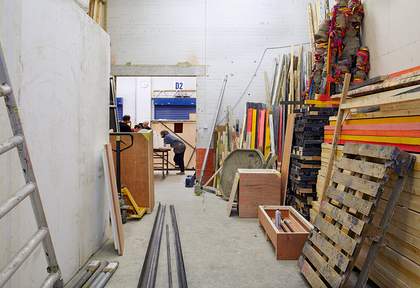
Phyllida Barlow and her work in her south London studio in November 2013
© Robin Friend
But a recent surge of interest in her art has meant that her working practices have had to change. After retiring from teaching in 2009, Barlow has received more and bigger commissions – in 2011 she filled the Hauser & Wirth gallery on Piccadilly with polystyrene blocks teetering atop tall poles, and last year invaded the Des Moines Art Center in the US with a forest of fabric-wrapped wooden forms. This year she will take on the colossal spaces of the Duveen Galleries for the Tate Britain Commission. As a result, she has moved into this much larger studio in a south London industrial complex.
And it is a place of industry. Eight overall-clad assistants, many her former students, beaver away in half a dozen different zones, including areas for woodworking, welding and construction, and a tarpaulin-covered space outside for painting. When Tate Etc. visits, the whole studio is dedicated to creating the Tate project. Barlow, who will be 70 this year, demonstrates how a process should be carried out, then checks on the work as it progresses.
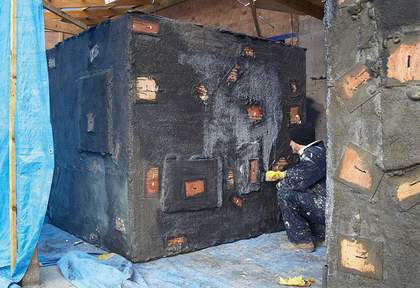
Phyllida Barlow's south London studio in November 2013
© Robin Friend
Unlike many of her previous sculptures which take form through constant layering, the installation at Tate will be pared back. ‘I’m always slightly uncertain when things are finished,’ she says. ‘I never really know. I like that uncertainty – you can do just one thing and the piece is completely ruined. For these Tate works there is a kind of clarity – they won’t get that far. They won’t get to a stage when they have to be stripped back, because I’m trying to hold them in check.’
She describes the studio as a kind of rehearsal space, especially for larger projects such as this. Despite a month being set aside for installation on site, this is not long enough for Barlow’s improvisatory and accumulative working methods. So each element will be tested here first, before being reassembled at Tate Britain. The piece will be enormous in scale, and the engineering demands that brings have required a new level of pre-planning, which Barlow has found ‘distressing’ but has resolved through carefully exploring approaches in the studio.
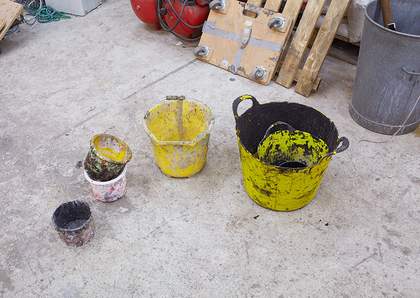
Phyllida Barlow's south London studio in November 2013
© Robin Friend
Her recent success has forced another change in her working process. She has been selling more, which means that less is available for recycling and more material comes fresh from the DIY store. Has this altered the end result? ‘It’s created a new ambition,’ Barlow says. ‘The works can be even more physically intrusive and more demanding in their use of space. Perhaps there is a greater sense of intention in the link between the structure and the additional elements. Before it was very clear one thing would support another, whereas now it’s become much more integrated.’
She plans to erect much of the Tate structure right across the entrance to the galleries. Is it her intention to frustrate visitors’ passage through the space?
It is more to raise an issue about what sculpture is for me, and I hope that might communicate itself to an audience. It’s a strange medium in that it takes up space, it takes up our space. It brings things into the world, and there is already too much stuff in the world. So it’s kind of absurd, and its absurdity is what I find fascinating. So perhaps it will mean that people will have to walk around it. I hope that will arouse curiosity about sculpture, about what it is and why it is what it is.


